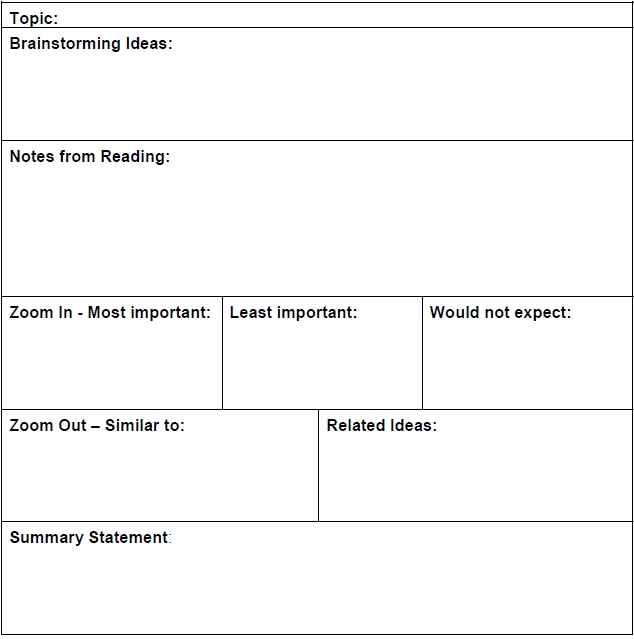Conceptualising by Naming

35
This is an energising activity that facilitates the exploration and discussion of concepts. All students write their definition of a particular concept on a card or post it note. In an open space they mingle with people greeting each other, exchanging cards and moving on until the agreed signal is heard. On the signal they stop and pair up. In pairs they discuss each definition on the card and agree on a score for each. The two scores must add up to 7 and be in whole numbers. The scores are written on each card. The group then mingles again, exchanging cards, discussing and scoring for a total of 5 times.
At the end of the fifth rotation students tally up the card they finish up with. The leader then determines which definition(s) received the higher or highest scores. These definitions are read out and discussed in terms of why they would have been rated so highly. This activity can also be sued in ‘Experiencing the known’ to draw out students’ prior knowledge about a concept or topic.
Affinity Diagram
The Affinity diagram is designed for groups of students to collect data and to sort it in a short period of time by looking for similarities and relationships.
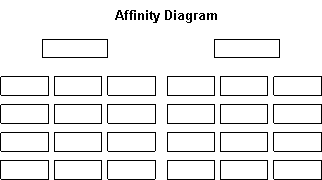
A-Z Ladder
This strategy enables students to record information they have encountered in a topic into a clearly structured retrieval chart. It can be completed as a class wiki to enable students to post entries over a period of time.
- Create a vertical list from A-Z.
- Attach a meaning to each word or phrase.
- Access information at different intervals of the unit to connect students to topic.
Bundling
Bundling encourages and scaffolds students to generalise and organise concepts. Students write 5 or 6 statements of what they know about a topic. Each idea or concept is written on a separate piece of paper, one idea to a piece of paper. In groups the students organise the information into categories by grouping the pieces of paper in bundles. The groups then put a general sub heading with each bundle. The concepts are then ordered within their bundle in the sequence they would form in a paragraph. Together these groups would decide on the topic title and write the paragraph cooperatively linking sentences together using connectives.
Character Profile
|
Personality |
Memories |
Physical characteristics |
|
Achievements |
Picture of character |
Relationships |
Classify by Concept
Group like and unlike things (words, images, objects) by their common characteristic (the concept classifier) and differences.
|
Concept Classifier 1 (e.g. colour, size, age, speed etc.) |
Concept Classifier 2 |
Etc. |
|
{list words, group images} |
Comparison Chart
Identify the similarities and differences between two things.
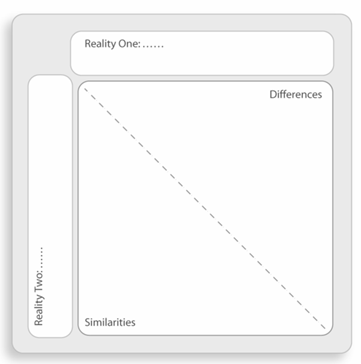
Comparison Matrix
Compare the characteristics of a number of different objects.

C-O-N-C-E-P-T
Convey the concept to the students by naming the topic that is being studied.
Offer the overall concept by explaining what it is related to.
Note the key words involved with the concept.
Classify characteristics about the topic.
Explore some examples and non examples to see if they fit the key concept definition and create data sets.
Practise with new examples and create a new data set.
Tie down a definition.
Concept Clarification
Clarify a concept by considering examples, and the things that it is like (synonyms) and the things that it is unlike (antonyms).
Concept: ………………
|
Examples |
Things Like |
Things Unlike or Opposite |
|
Concept Definition: |
||
Concept Organiser
Create a concept graphic organiser:
- Name the concept, putting it in a circle at the middle of the page.
- Connect it with Characteristics, in boxes linked to the concept with lines.
- Provide Examples of each characteristic, in different-colored boxes linked to that characteristics.
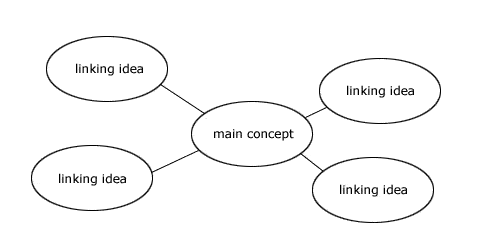
Concept Webs
Concept webs encourage learners to visually record their learning through an exploration of issues or topic. The process establishes connections and helps the learner organise ideas and understand relationships between different concepts, problems and ideas. They also develop vocabulary.
The centre circle contains the main concept, problem or topic. Linking ideas or solutions are recorded in the outer circles through the use of key words. Lines may be added to link the connecting circles to each other as well as to the central circle. Images and colours may also be used to enhance the concept map. Use different geometric shapes to make them interesting.
Cross-Classification
Group like and unlike things by their conceptual similarities and differences on two conceptual dimensions.
|
Gender Dimension: Boys |
Gender Dimension: Girls |
|
|
Age Dimension, 0-5 |
||
|
Age Dimension, 5-10 |
Dictogloss
This activity prompts students to listen for meaning, looking for key concepts. Once a work is introduced and placed in context, with key vocabulary discussed, read the text at normal speed. While the text is being read a second time students write down key words. These words can be recalled by the students and collected on a shared board. The text may be read a third time if needed.
The students, individually or in groups, reconstruct the text retaining the author’s intent with meaning and style.
D-I-S-S-E-C-T Word Identification Strategy
Discover the word’s context by using clues in the text.
Isolate the prefix and assess the meaning (skip if there is no prefix).
Separate the suffix (skip if there is no suffix).
Say the stem or base word.
Examine the stem be separating letters to make decoding easier.
Check with someone if necessary.
Try the dictionary if still having difficulties.
Frayer Model

Glossary
Create a list of key concepts for a topic or area of activity, which would be able to explain that concept to a person new to that topic or area. Each definition should:
- Define Up: What or bigger idea or larger group of concepts, does the concept belong to? (The parent or parents of the concept.)
- Define Against: What are the other concepts in its group? How is this concept similar or different to these concepts? (The concept’s siblings.)
- Define Down: What are examples or instances of this concept? What does the concept include or consist of? (The children of the concept.)
Gold Panning
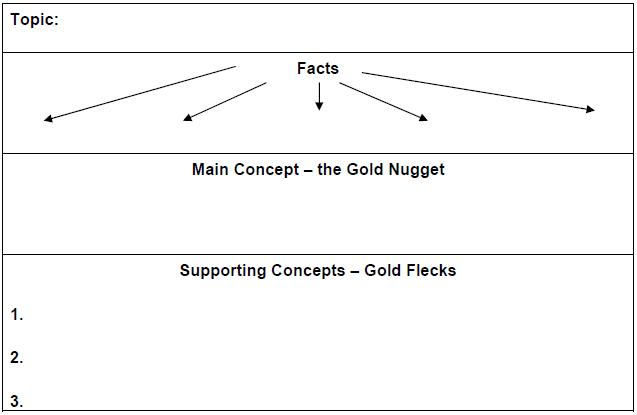
Inductive Reasoning
Examine facts closely and develop useful concepts which describe similarities and differences, patterns, things that are not immediately obvious.
|
Fact, fact, fact |
-> Reasoning -> |
Concept |
Information Retrieval Grid
This enables students to organise and record information. A grid is constructed with focus questions along one axis and items along the other. Students read the text and complete the grid by recording ticks or words in the boxes. When the grid is complete students discuss their findings using comparatives or connectives.
|
Name 1 |
Name 2 |
|
|
Focus Question 1 |
||
|
Focus Question 2 |
||
|
Focus Question 3 |
Information Text Pyramid
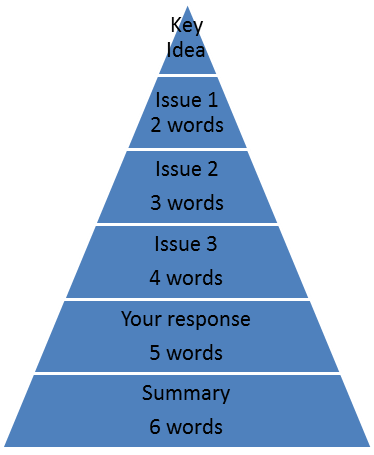
This can also be use as a narrative pyramid.
1 word: Character’s name
2 words: Describe the character (orientation)
3 words: Describe the setting (orientation)
4 words: Describe the complication
5 words: Describe the resolution
6 words: Your response
Inquiry Charts
|
Topic |
Who invented it? |
Types |
Important people |
Influences |
Interesting facts |
New questions |
|
What we know |
||||||
|
Source 1 |
||||||
|
Source 2 |
||||||
|
Source 3 |
||||||
|
Summaries |
Interesting Word Chart
|
Word |
My definition |
Reference |
A modification of this activity is complete definitions at different stages of the reading.
| Word |
Before Reading |
After Reading |
After Discussion |
Literacy Concepts: Develop a Metalanguage
Use concepts which describe patterns in language using keywords which describe language features. For example: heading, list of points, topic sentence, paragraph, hyperlink, reference.
Multiliteracies Concepts: Develop a Metalanguage
Use concepts which describe patterns in texts which use two or more modes: language + image + sound + gesture + space. For example: perspective, framing, pitch, volume, body language, proximity.
Naming an Image and its Parts
Caption and label an image.
- Caption: The image as a whole.
- Labels: The main parts or aspects of the image.
Question Answer Relationships (QAR)
Students answer and/or devise questions according to four categories:
- Right There questions – the answers are located in the text at the literal level and generally ask who, what, where, when, identify, list, name, define etc. This type of question requires students to find the exact words in the text.
- Think and Search questions – require students to make connections between ideas; these questions often say compare and contrast, explain, tell why, find evidence, what cause/effect, problem/solution and what is the main idea. Students have to work out an answer from more than one sentence, paragraph or page.
- Author and Me questions – students use information and ideas that are not directly stated in the text. These questions require the reader to infer and to formulate their own opinions. They might say the author implies or suggests or what is the author’s message.
- On My Own questions – Students draw on their prior knowledge and experience. The questions might say in my opinion, I think/believe or based on my experience.
QAR teaches reading comprehension strategies such as skimming and scanning and rereading. Model the type of questions initially and ask students to sort and discuss them before they develop their own questions in pairs, small groups and then individually. It is important that students can identify the different sorts of questions so that they can use the right strategies to formulate an answer.
Plot Profile
This is a strategy designed to increase students understanding of story structure in narrative texts, as well as engaging children in the reading process. In response to a text read individually or in class students list the major events in the story. These events are then rated against indicators such as excitement, suspense or humor. This is plotted on a graph numbering the events, listed in detail in a key, along the horizontal axis and the appropriate rating along the vertical axis.
Ranking Main Ideas
After reading/viewing a text, students identify key ideas/themes/ concepts and order them. Use post it notes so ideas can be rearranged during discussion in small groups or as a whole class.
|
Most important ideas |
|
Moderately important ideas |
|
Least important ideas |
Semantic Webs
Semantic webs enables to students categories concepts and make logical links between concepts and ideas. Students use a single focus question as the starting point, writing it at the top of their page. Sub headings are chosen to go across the page, under the focus question. These sub headings are known as web strands.
Under the web strands students make notes relevant to each strand. These become known as strand supports. When the semantic web is complete it can be discussed at group or class level.
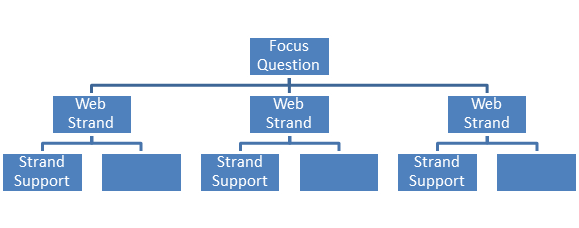
Sketch to Stretch
Students use this tool to generate understandings of ideas and concepts in a narrative. Students read a text silently or the teacher reads aloud, stopping according to density of the text and purpose of the lesson. During a pause the students sketch a summary of the story so far. After a series of pauses the students will have a series of sketches which they share with a partner, comparing inferences from the text that have been made during their sketches. A variation is for students to sketch what they think is going to happen next or would like to happen next.
Sociogram
A literary sociogram is a graphic organiser that represents the relationships among characters in a literary text. In a sociogram, the central character is placed at the centre of the page and the other characters are placed around it. Arrows are used to show the direction of the relationship and a brief description of the nature of the relationship is placed alongside each arrow. Students manipulate pieces of paper with the names of characters, until they feel they have arranged them in the best way to reflect their understanding of the text. Then the names can be attached to a piece of paper and the rest of the sociogram devised. A number of conventions may be useful in developing sociograms:
- Place the central character/s at the centre of the diagram.
- Let the physical distance between characters reflect the perceived psychological distance between characters.
- Let the size of the shape representing a character vary with (a) the importance, or (b) the power of the character.
- Show the direction of a relationship by an arrow, and its nature by a brief label.
- Represent substantiated relationships by a solid line and inferred relationships by a broken line.
- Circle active characters with a solid line. Circle significantly absent characters with a broken line
- Place the characters who support the main character on one side of a dividing line, and antagonistic characters on the other (goodies vs baddies).
When working with simple stories, one sociogram may be enough to capture the relationships. With longer or more complex stories, a series of diagrams will help to capture the changing relationships. Students can work independently and then share their sociograms or small groups of students can work collaboratively.
Younger students can use pictures of characters and word cards to construct their sociograms. Software such as Inspiration or MindMan could also be used. Sociograms can be used to help explore power relationships implied in non-fiction texts such as newspaper reports and feature articles, aiding in the development of critical literacy skills. Listening carefully to students’ explanations of their sociograms helps to provide insight into their comprehension and their ability to make inferences from texts.
SQ3R
Survey: Look through the chapter that is going to be studied for an overall idea of the topic.
Question: Turn each heading into a question.
Read to answer the questions.
Recite: At the end of each section, try to answer the questions without looking back; do not take notes until the entire section is read.
Review what you have read; work with a partner to go over all of the questions you asked and try to answer them.
Structured Overview
This tool enables students to gain an overview of the big understanding. Select a topic and ask each student to write down ideas on the topic – each idea on a separate piece of paper. They then share their ideas in a small group. The group then writes the topic heading on a large piece of paper and gathers their ideas into categories which they jointly define. The categorised groups are then written on the large piece of paper and linked appropriately. The overviews are then shared with the whole class.
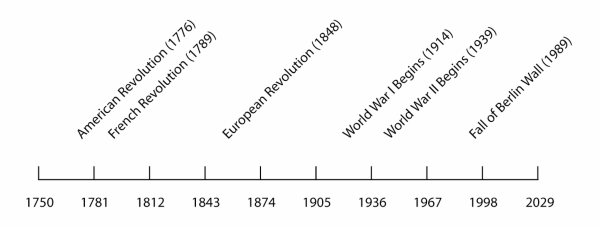
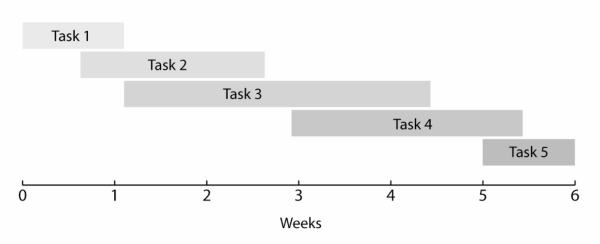
T Chart – Naming
|
Positives |
Negatives |
|
|
|
An extension of the T Chart is a Ying and Yang diagram to explore arguments, balancing one idea with an opposing or balancing idea or perspective.

A T chart can also be used to identify inferences and evidence to support those inferences.
|
I think …… (your inference) |
Because……… (evidence from the text) |
Timeline – Name Periods of Time
Create a timeline, either with dates/time marked as points-in-time along a line, or with overlapping periods of time such as in a Gant Chart.
Venn Diagram
What are the different and overlapping common features of two things?
- Item A: Distinctive Features
- Items A and B overlap: Common Features
- Item B: Common Features

Vocabulary Building
|
Brainstorm: Before reading brainstorm words that are related to the topic and which might appear in the text. |
|
Categorise the words and label each category: |
|
After reading: Add other key words to the categories. Add any new categories. |
|
Paired writing on one of the categories: |
Vocabulary Concept Map
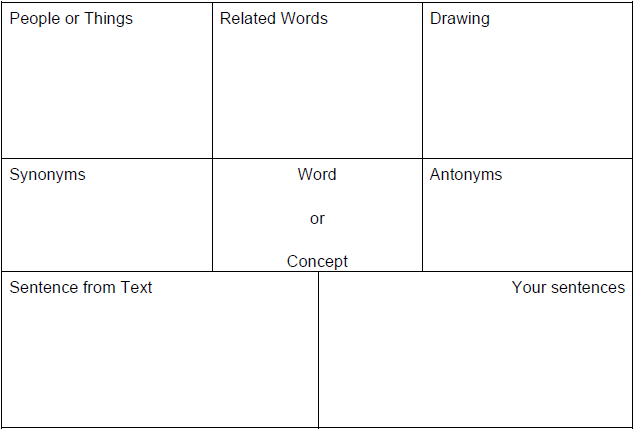
Word Association
This strategy supports students in generating new ideas or to find creative solutions to problems.
- Decide on a topic that needs a solution generated to solve a problem
- Think of an object or word that has nothing to do with the topic needing new ideas or problem.
- Brainstorm associated words, opposites, puns etc. Look for more associations until they create an idea. Place a box around the idea
Word Cline
Students generate synonyms for words. They then categorise the words, e.g. from most intense to least intense. Students then discuss these in relation to the choices authors make and to inform their own creation of texts.
Word Sorts
Use word sorts to identify sounds, syllables, rhymes, onset and rime and common patterns. For an open sort, students sort the words according to their own judgement. This helps them to see the connections in words. They then assign a title or label to the categories they have identified. In a closed sort, the teacher selects the categories. Students can reflect on whether they agree with the categories, the common features, how they have categorised the words, and how the words might relate to the text from which they have been drawn.
Y Chart – Naming
Analysing the obvious features of something. What it: Is it identifying/naming rather than analysing?
- Looks like
- Sounds like
- Feels like
An extension of the Y chart is the X chart which includes Thinks Like.
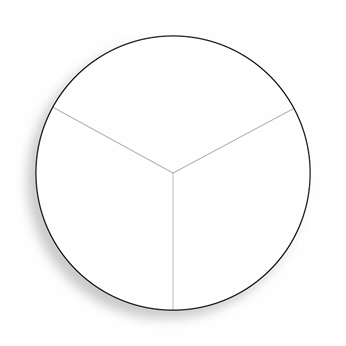
Zooming In and Zooming Out
